The Grueling, Rain-Drenched Magic of 2024’s 24 Hours of Le Mans
Sixty-two cars started the 24 Hours of Le Mans, and after the 46 that finished completed their cool-down laps and circled backwards through pit lane to arrange themselves on the front straight, the people started running. Not in an effort to beat traffic on the narrow streets of the small French town of Le Mans, but onto the rubber-streaked pavement of the track, to celebrate.
Some carried camping chairs in slings over their shoulders. Others carried backpacks. Some held flags. They ran pell-mell down the front stretch, in the opposite direction of the cars that had roared for the past 24 hours, toward the podium on the Rolex-liveried pedestal. Soon, the front straight of the Circuit de La Sarthe was choked with as many of this year’s 329,000 attendees as would fit. The winning teams lifted their trophies and sprayed themselves with champagne, a tradition invented here by Dan Gurney in 1967. Then and now, the crowd cheered.
Back in the paddock, as the music of a brass band filtered up and over the grandstands, the Cadillac crew filed from the garage into GM’s temporary team headquarters. Next door was the Porsche suite, where a television broadcast showed the wreathed, smiling winners. Changed out of his driving suit into a team polo, Cadillac driver Alex Lynn couldn’t help but watch.
Thirty-five minutes after the checkered flag flew, another of Cadillac’s racers, Jack Aitken, walked in rolling a suitcase, accompanied by his fiancée. Inside the subdued GM suite, at a table away from the rest of the crew, the team manager of the No. 311 Cadillac, 71-year-old Gary Nelson, sat red-eyed.
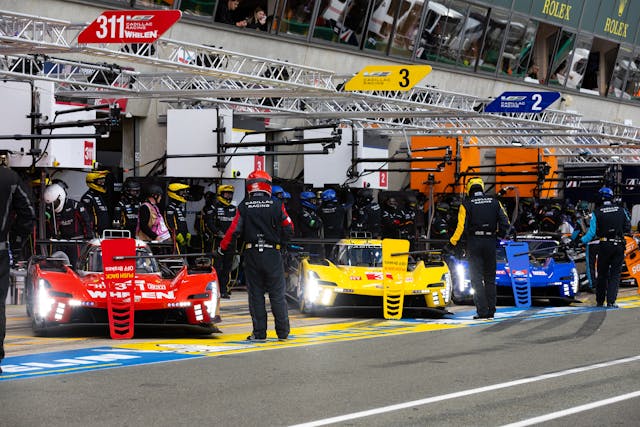
Three factory-backed Cadillacs traveled to Le Mans this year, one fielded by Nelson’s Action Express and two by Chip Ganassi Racing. Last year, GM returned to compete in the top class at Le Mans for the first time since 2002. Cadillacs finished third and fourth. “We got a couple minutes to just be completely blown away by saying, ‘Hey, we had this success,’ and then the hunger set in,” said Laura Wontrop Klauser, manager of GM’s sports car racing program, shortly before this year’s race. “The only answer from here on out is first place. That’s it.” A win in 2024, she said then, “would be all everyone has been working for since we took the checker at Le Mans last year.”
On the Thursday before this year’s race, Cadillac’s confidence seemed well-founded. Sebastien Bourdais in the No. 3 Ganassi Cadillac nearly qualified on pole, but at the very end of the Hyperpole shootout—the final event in the multi-day qualifying sequence—Kevin Estre in the No. 6 Roger Penske-run Porsche edged him out by 0.213 seconds. In the pits, the Penske team jumped and hugged each other. The No. 2 Ganassi Cadillac, driven in qualifying by Alex Lynn, carried a five-place grid penalty from a crash the car caused at last month’s 6 Hours of Spa race, and although it was faster than the No. 3, it started seventh on Saturday.

Gary Nelson’s No. 311 qualified 18th, after the team misjudged the amount of time needed for the car to pass through scrutineering on Wednesday ahead of the free practice session from 10 a.m. to 12 p.m. Figuring they would be at the track until midnight, Nelson told his crew to roll the car up to the scrutineering building around 8:30, one and a half or two hours later than they normally would for an IMSA race. When they pushed their car up at 8:45, they were 50th in line, and they missed the entire practice session. That put them behind for all of Thursday, during which the last two free practice sessions are held—one in the daylight, the other at night.
“It sounds so trivial,” Nelson said on Friday morning, “but that’s how Le Mans is.” He was sitting in the GM hospitality suite, both hands wrapped around a latte. “Failure in leadership—it’s all on me.”
Nelson’s a lifelong racer. He was the crew chief for Bobby Allison’s 1983 Winston Cup championship season, and then one of NASCAR’s top executives for 16 years. Nelson was hired in 2010 to run the brand-new Action Express sports car team, which won its very first race: The Rolex 24 at Daytona. Since then, the team’s won six IMSA championships.
During the nighttime practice on Thursday, the scene in the garages of the Ganassi-run Cadillacs was one of calm preparation. They mounted the front bodywork that the cars would start the race with, then the spare, and did the same for the tail pieces, making sure the lights in each one worked. The pit crew installed a set of grooved rain tires so a driver could take them out for a lap to scrub off the mold-release agents applied when the tires are made, to keep them from sticking to the mold. (Teams are only allowed to scrub rain tires, not their sets of dry-weather slicks.) The mold-release agents are slippery. After a suitable scrubbing, the surface of the tire looks matte, not shiny.

Friday dawned, worthy of a summer picnic. Cows grazed in a field between a campsite and the horse-racing track that’s within the compass of the nearly 8.5-mile circuit. Foxglove waved along a wooded dirt path leading to the paved sidewalks closer to the track, which is a mix of public road and dedicated race course. The sound of a distant swarm of race cars filtered through the air, but it didn’t belong to the weekend’s participants: They don’t take to the track at all on Friday—instead, they spend the day participating in the fanfare that makes Le Mans feel like a festival. That sound was coming from 118 Volkswagen Beetle-styled race cars competing in the four-hour Fun Cup series race.
All the drivers parade through the town that afternoon, while the track is open to fans—on bikes, scooters, or on foot. Most proceed casually, but many are serious runners and cyclists. Later that afternoon, crews stage the cars on the grid, which floods with fans eager to ogle the cars and to spot celebrities, including Roger Penske who, at 87, has won everything but Le Mans.
Faced with a massive crowd pushing toward the machines they so painstakingly prepared for tomorrow’s race, the attitude of the crews ranges from casual to guard dog. The diversity of the fans is striking. For every 60-something man wearing Gucci loafers or a floral print polo and a gold chain, you’ll see two or three couples under the age of 40, holding hands, looking like they are simply out for an easy weekend stroll. Most weren’t even wearing team-branded gear. Since admission is free for those under 16, children are a common sight, including some in carriers on their parent’s backs.
That evening, the party atmosphere was alive and well at the Village, a cluster of temporary displays, restaurants, bars, and merchandise stores set up in the infield toward the end of the paddock. Rain had poured in torrents during dinner but had since passed, leaving the air feeling freshly washed. In the Ford Motorsports building, the newly revealed Mustang GTD Carbon Series drew a cluster of admirers. Across the way, the Norse-looking DJ at a display for BYD, the Chinese electric car company, bobbed his head to Method Man’s “Even If.” Fans of all ages—parents, kids, young adults—thronged the stores and displays.
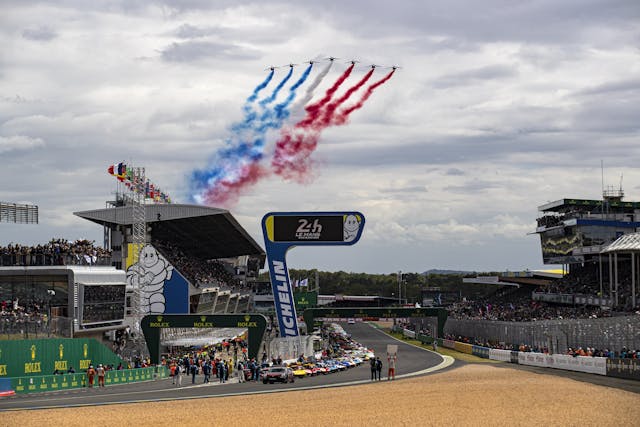
At 3 p.m. the next day, an hour before the race started, the grandstands by the front straights were already packed. A strong breeze had been blowing, revealing patches of blue sky and wafting smells of grilling meat and the occasional cloud of berry-smelling vape. As start time approached, jets roared overhead, their exhaust streaked with the blue, white, and red of the French tricolore. The arrival of the trophy, then the starting flag, drew cheers. French soldiers ziplined out of helicopters, which thwopped their way low over the roofs of the stands. Another cheer, this time for French Formula 1 driver Esteban Ocon, who’s been sighted walking by the garages.

There are three classes of cars arranged on the starting grid. The Cadillacs belong to the top, fastest class, formally dubbed Hypercar. These cars, generically referred to as “prototypes,” are piloted by pro drivers, those who make their living from racing. Teams are allowed some flexibility in powertrain configuration, but the weight and size of the cars, along with their maximum power and even the shape of the powertrain’s torque curve, is governed by strict rules. The Cadillacs are up against heavyweights in the endurance-racing world, including Ferrari, which won last year, and Toyota, which won each of the five years before that. This year the Porsches are the responsibility of an American team, Penske Motorsport. The German marque has the most wins of any manufacturer at this circuit—most recently in the 919 Hybrid from 2015–17.
You’ll easily recognize the cars in the Le Mans GT3 class because their bodies and engines are based on production designs: The BMW M4, Corvette Z06, Ford Mustang, Aston Martin Vantage, Lamborghini Huracan. Unless you follow endurance racing, you wouldn’t recognize any of the cars in the Le Mans Prototype 2 class, comprised of scratch-built cars of identical design. LMP2 cars are faster than the LMGT3s, but slightly slower than the Hypercars, and the pro-am LMP2 regulations provide for the inclusion of some amateur drivers.
The Corvettes and the Mustangs are new designs, untested at Le Mans. The Corvettes, in a break from a long tradition, are entered not by Corvette Racing, the factory outfit, but by British team TF Sport, which typically runs Vantages. The Mustangs are fielded by Proton Competition, a German team long associated with Porsches.
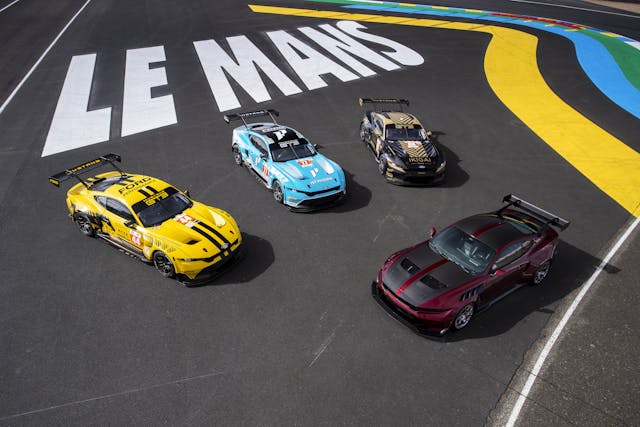
The engines have fired, and team radio chatter during the warmup lap reveals that the breeze has blown sticks and dirt and leaves onto the track, large portions of which are lined with trees. Drivers weave from side to side, using friction to generate heat in the tires. They press the accelerator and then the brakes, using the same strategy to heat up the rotors and pads.
The pace car swings into the pit lane. The green flag waves. With a roar, 62 cars surge forward. The animated crowd in the grandstands, standing since the cars rolled onto the circuit, cheers.

Ferrari comes out swinging, its team cars aggressively passing the front-row Cadillac and Porsche and setting a blistering pace from the outset. Forty-five minutes in brings the first round of pit stops, during which most teams simply refuel. The No. 50 Ferrari pits around the same time as the No. 3 Cadillac, but emerges just a touch sooner. As both cars merge into the lane that leads back to the track, the Ferrari cuts off the Cadillac. “What the hell was that?” comes over the Cadillac radio. Five minutes later, the No. 99 Porsche is already in the garage: Something’s wrong with the door-closing mechanism. Moments on, a LMP2 car is in the gravel. The race stewards have noted the aggression of the No. 50 Ferrari in pit lane, and the car incurs a 10-second penalty for its next pit stop. Within the first two hours, a Toyota—their cars started 11th and 23rd—has climbed to second. For a 24-hour race, the opening hours are frenetic.
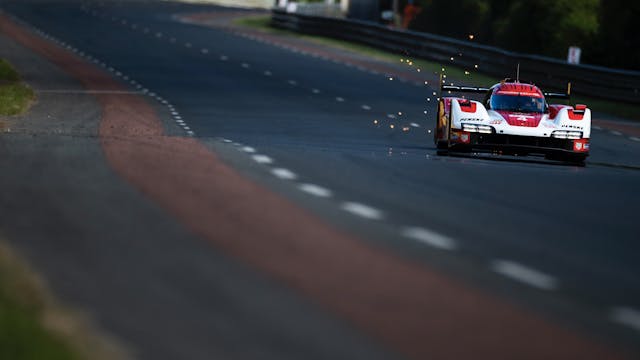
At the campsites behind the Indianapolis corner, which is a 90-degree left, strings of lights swing above motor homes and tents. As dusk fades into night—late, since the summer solstice is only days away—the sounds of the cars seem more pronounced. The LMP2 cars, with their identical crackles, sound like Rice Krispies at 110 dB. The Cadillacs bellow; at 5.5 liters, their V-8s are the largest by displacement in their class, and the only engines not turbocharged. The V-8 Aston Martins boom and thunder, the V-10 Lamborghinis snarl.
Rain washes down the track just after nightfall, and the cars wiggle on corner exit, each sashay provoking a surge of “oooohs!” from the crowd in the stands. Exhausts spit blue fire that you can’t see in daylight. Corner workers hunch under rain jackets.
Ferrari hasn’t let up. Around 11 p.m., while navigating through traffic, the leading Ferrari side-swipes the No. 15 BMW Hypercar, sending it into the wall at the end of the Mulsanne straight. A safety car appears, allowing marshals time to drive a crane onto the track and recover the BMW. Rain still sprinkles. Around midnight, a firework show explodes through the air.
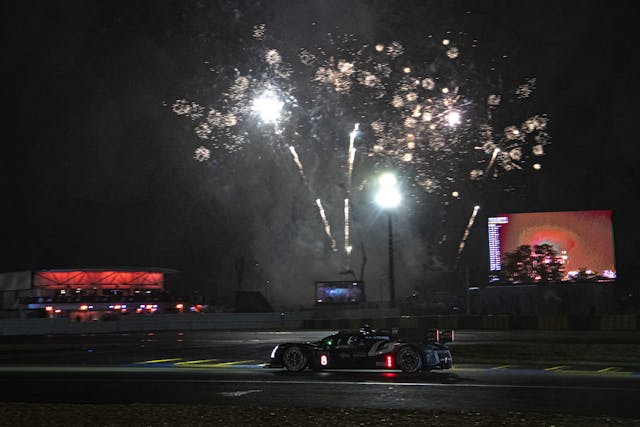
Up at the Village, one outer wall of the Ferrari store holds a giant TV screen, captivating a handful of rain-jacketed fans with backpacks, most holding light beers in plastic cups. A few minutes after midnight, the screen goes black and the store closes. The lights remain on at the shops selling Le Mans-branded merch. A DJ’s set, riffing on “What Is Love,” pulses from the Peugeot tent. When the safety car retires and racing resumes, fans cluster to watch the cars roar up the incline toward the Dunlop Bridge. They huddle, not talking much, smoking cigarettes and taking pictures. By 1 a.m., Toyota is leading—the No. 8 car, with Sébastien Buemi driving. The No. 2 Cadillac is in fifth.

At 3:45 a.m., rain returns, the heaviest yet. The cars raise rooster tails of spray down the front straight. In the grandstands, a few fans still huddle, and some have room to stretch out in their sleeping bags. Water puddles on the front straight. The yellow flag flies, and the safety cars return to the track. The racers take the opportunity to pit. The rain steams off the grooves of the tires under the stark lights. The race engineers do their best to keep up the spirits of the drivers as the action stagnates. “We’re still planning on chicken tonight,” comes a friendly voice over the radio to IndyCar champion Alex Palou, driving the No. 2 Cadillac. “Don’t let us down.”
It’s 4:23 a.m., and dawn is an hour away. At 6 a.m., the safety cars are still out; for more than four straight hours, the field chugs along behind them. The streets of the infield nearest the paddock are nearly deserted. Not long after, the safety cars start running out of gas and have to refuel.
By 9 a.m., the sky reveals a novel sight: shades of blue. A strong breeze blows clouds in front of, then away from, the sun’s rays. The safety cars retired 50 minutes ago and racing resumed, and the No. 6 Porsche has built an 18-second lead. The No. 7 Toyota and the No. 50 and 83 Ferraris battle behind it. An Aston Martin LMGT3 car hits a wet patch, careens into a tire barrier and flips, landing on its roof. The driver is OK. The camera cuts to its garage, showing tears and long, tired hugs.
At 10:15, a new face leads the race—the No. 2 Cadillac!

About 10:40 a.m., disaster strikes its remaining sister car, the No. 311 Cadillac—Pipo Derani spins it into the tire wall. He manages to limp back to the garage. Gary Nelson’s Whelen crew doesn’t hesitate; they grab the parts, take out the tools. At some point during the repairs, a crew member asks team manager Nelson if they’ll be able to fix the car. “We’re not quitters,” says Nelson. “We’ll find a way and if it doesn’t work, then that’ll be okay, but at least we’re going to try.” Around 12:15 p.m., the No. 311 emerges from the garage. It’s 31 laps down, wearing a new nose, right side pod, engine cover, tail, right rear suspension, and radiator.
More rain. The No. 2 Cadillac comes in for wet tires, replacing the new slicks installed just minutes ago. A crew member carrying a new windshield wiper reaches over the front of the car, yanks off the old arm, and puts the new one on—almost. Tries again, fails. Finally, gets it. The tension is agonizing.
Coming into the last hour, it’s raining yet again. The grandstands are packed with fans. Umbrellas have sprouted like mushroom caps. Two large Toyota Gazoo Racing banners hold their heads high, the fabric limp with rain. Several rows away, a tiny, bright red flag—for Ferrari, presumably, is waved as enthusiastically as if the race had just begun. We’re down to the final pit stops. The winner will be whoever uses their fuel wisely. Ferrari has decided to eke out two 13-lap stints—usually, the allotted amount of energy lasts for 12. In the pits, the crew of the No. 50 Ferrari appears to be nearly frozen, fingers held to mouths, a hand grasped on a coworker’s leg, a knee unconsciously bouncing. The race broadcast shows the amount of remaining energy—accounting for fuel and for hybrid power—across all the cars. Ferrari is at four percent, then three. At two percent, it wails across the finish line. Tears stream down the faces of the crew members, who’ve leapt to their feet and into each other’s arms.
Over the Cadillac team radio, the driver of the No. 2, Alex Palou: “Couldn’t push it anymore. Sorry.” They finish seventh.
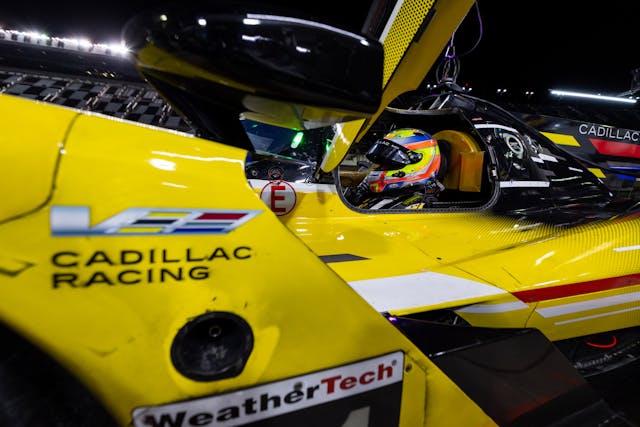
Holding his young son on his shoulders, Tom Ferrier, the director of the TF Sport team fielding the Corvettes, is all relief. “It wasn’t the smoothest [race] for us,” says Ferrier. One of the two Corvettes was plagued with clutch issues, and both finished toward the back of the LMGT3 field, 11th and 15th in class. It’s not the placement the audience would expect from America’s Sports Car at Le Mans, but the team is new to the car and vice versa. Le Mans was only the fourth race for TF Sport and the new, GT3-spec Corvettes, which the team received in January. It appears that Chevrolet, along with TF and the supporting crew from Pratt and Miller, who built the car, had sane expectations. The tired Ferrier smiles. “Very, very happy to get them home.”
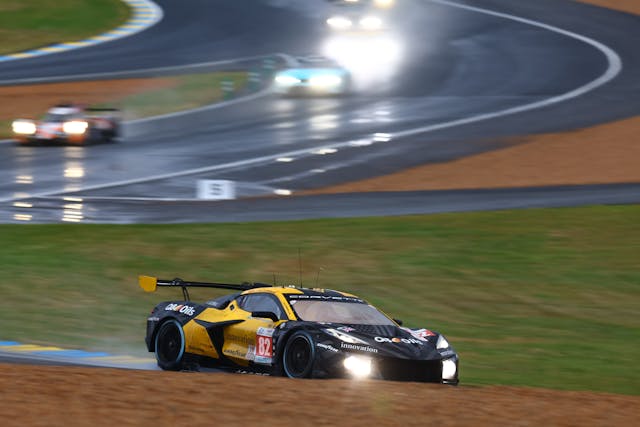
The other LMGT3 newcomer, the Mustang, was a surprise success. The pony cars suffered their own share of drama but, in the end, fared better than the Corvettes. Proton Competition fielded three Mustangs, and two of them finished third and fourth in class. Time spent replacing the steering rack in the third car sank it to 17th. The walkway into the Proton garage was filled with plastic crates of beer in brown bottles. The atmosphere was one of happy relief. “It’s the first season of the car and it’s always difficult in your first year to have a car race-ready technically and performance-wise,” says team principal Christian Reid, holding one of the brown bottles. “Clearly looking back to the first race in Daytona in IMSA, and Qatar in WEC, we struggled a lot, but lessons learned. I am super happy.”
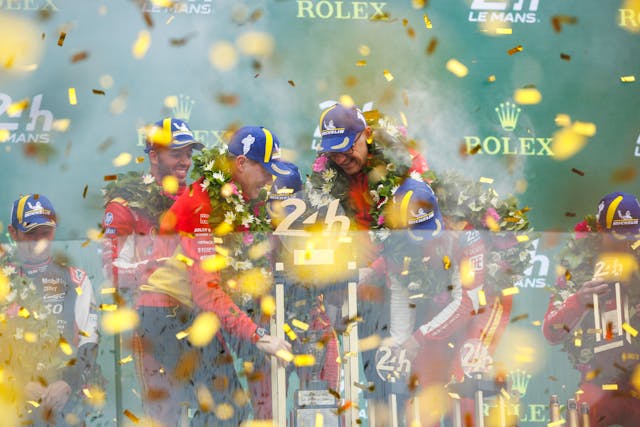
In the GM hospitality suite, while outside the brass band played for Ferrari, Gary Nelson sits at a table away from his crew. His eyes are red, his hands folded. The first words out of his mouth reveal an exhausted softening of the consonants. “You going to make us famous?”
He starts by praising his team’s work repairing the 311, then shifts into analysis. They were behind Thursday—his mistake. The rain caught them off guard. Then Derani put the car into the wall. “I ended the day not real thrilled.”
He takes a sip of the Corona at his elbow. The first laughs break from other side of the room, where his crew sits with their beers. “I’m going to walk over—they’re all over on the other side, they’re the loud ones—and I’ll have a couple words with them, you know, thanking ’em. And probably my theme is winners never quit and quitters never win, and they’re not quitters. So I think that’s pretty much all I’ll say. Or I might just yell at ’em all.” He chuckles, showing white teeth.
He’s kidding. He never yells at his team.

***
Check out the Hagerty Media homepage so you don’t miss a single story, or better yet, bookmark it. To get our best stories delivered right to your inbox, subscribe to our newsletters.



I enjoyed the race this year – except the long rain patch, of course. A bit disappointed in some of the American car’s failings, but that’s racing, as they say. Very nice recap and summation, Grace! You threw on a lot of detail and observations that we TV viewers missed out on. Enjoyable story!
When the 77 Proton Mustang had that early front suspension failure I thought ‘ Oh no here we go ‘ . But when the head engineer immediately read the crew the riot act, slammed down on her knees and started pulling off the nose… admittedly from a skewed male perspective… there was a certain undeniable , ‘Now that’s my kind of girl!’ that I won’t forget, and a snippet that might sell cars.
Great race report. Wonderful detail, lots of genuine emotion. Bravo. BTW, I was reporting from Daytona on the Gary Carter/Bobby Allison team in ’83. He was aa great crew chief. I still think of him as a young guy. Funny how that works.
Le Mans never fails for drama. Great racing as always.
I went to Le Mans every year from 1970 – 1995 with the exception of 1988 – typically the year Jaguar won – and it’s a race like no other. One of my abiding memories is of the huge chrome filled Peterbilt trucks of, I think, the Whittington Bros. In England lorries tend to be very mundane workhorses so the glamorous American versions were as interesting as the race cars. The Corvettes always stood out as they trundled by with their very deep rumble compared to the screaming exhaust notes of the other runners. It took a moment to realise that they were going just as fast. Of exhaust notes in general probably the most memorable were the Matras you could hear them the entire way round the circuit. My body at 81 has condemned to watching from an armchair but I’m so glad I did it live.
Thank you, Grace Houghton, for a beautifully written article, full of detail, suspense and emotion. I didn’t see the race, but I certainly experienced it, thanks to your wonderful narrative.
Not to be confused with 24 Hours of Lemons.
What a great write up of this absolutely extraordinary race. We attended Le Mans as a young couple in 1988 the year Silk Cut team Jaguar won again, after a decades long gap. The finished first and third I think. We had travelled all the way from Swaziland, where I worked and was rebuilding a 1964 Jag. It had always been on my bucket list, and I would love to go again one day. This essay has made me even more determined. Such great writing, you have captured the atmosphere so well.
we long ago ran Pell-mell into the era where racing does little to nothing to improve the breed so it is difficult to find interest in motorised lab experiments strictly controlled by computer and budget..the two things most anathema to everyday drivers;
race cars today might as well be piloted by Simians from Space Odyssey 2001 much like the space programme used to be..why send a driver where you can send a computer programme?
racing sadly has become that esoteric and antiseptic the cars all look like identical cookies on a baking sheet course, extensions of a child’s slot racer course from the mid 1960s..and we all know how that ended up another castaway toy;
what could be a more inevitable fitting end of today’s grown up slot racers?